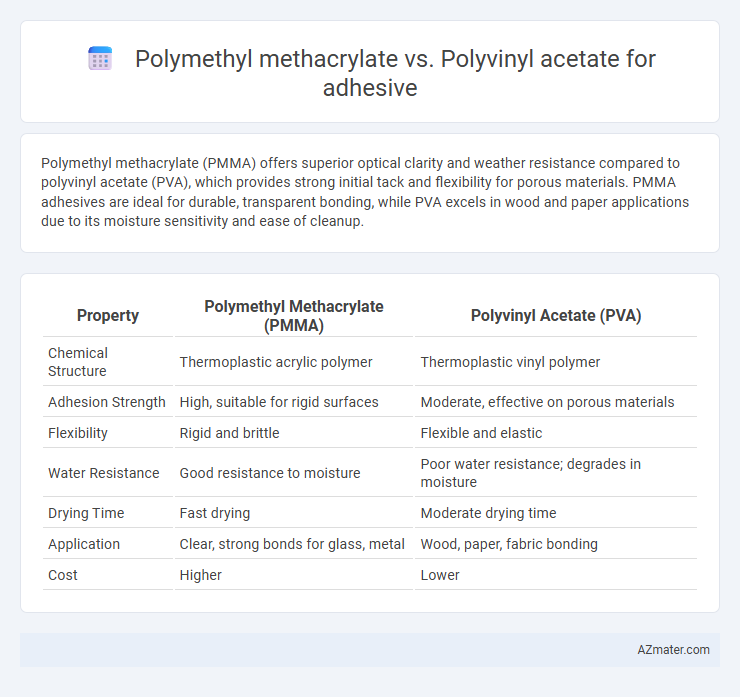Polymethyl methacrylate (PMMA) offers superior optical clarity and weather resistance compared to polyvinyl acetate (PVA), which provides strong initial tack and flexibility for porous materials. PMMA adhesives are ideal for durable, transparent bonding, while PVA excels in wood and paper applications due to its moisture sensitivity and ease of cleanup.
Table of Comparison
| Property | Polymethyl Methacrylate (PMMA) | Polyvinyl Acetate (PVA) |
|---|---|---|
| Chemical Structure | Thermoplastic acrylic polymer | Thermoplastic vinyl polymer |
| Adhesion Strength | High, suitable for rigid surfaces | Moderate, effective on porous materials |
| Flexibility | Rigid and brittle | Flexible and elastic |
| Water Resistance | Good resistance to moisture | Poor water resistance; degrades in moisture |
| Drying Time | Fast drying | Moderate drying time |
| Application | Clear, strong bonds for glass, metal | Wood, paper, fabric bonding |
| Cost | Higher | Lower |
Introduction to Adhesive Polymers
Polymethyl methacrylate (PMMA) and polyvinyl acetate (PVA) are widely used polymers in adhesive applications due to their distinct chemical structures and bonding properties. PMMA offers high strength, transparency, and resistance to environmental factors, making it ideal for structural and optical adhesives. PVA provides excellent flexibility, strong adhesion to porous materials, and rapid setting, commonly utilized in woodworking and paper bonding.
Overview of Polymethyl Methacrylate (PMMA)
Polymethyl methacrylate (PMMA) is a transparent thermoplastic widely used in adhesive applications due to its strong bonding properties and excellent clarity. PMMA adhesives offer superior weather resistance, UV stability, and durability compared to polyvinyl acetate (PVA), making them ideal for outdoor and high-stress environments. The high tensile strength and chemical resistance of PMMA contribute to its effectiveness in bonding glass, metals, and plastics in various industrial and consumer products.
Overview of Polyvinyl Acetate (PVAc)
Polyvinyl Acetate (PVAc) is a widely used adhesive known for its excellent bonding properties on porous materials such as wood, paper, and fabric. It offers strong initial tack, flexibility, and resistance to aging, making it ideal for woodworking and paper-based applications. Compared to Polymethyl Methacrylate (PMMA), PVAc is more cost-effective and environmentally friendly due to its water-based formulation and easier cleanup.
Chemical Structure Comparison
Polymethyl methacrylate (PMMA) features a rigid polymer backbone with ester functional groups providing strong adhesion and durability, while polyvinyl acetate (PVA) consists of a flexible vinyl backbone with acetate groups that yield excellent tackiness but lower mechanical strength. The methacrylate side chains in PMMA contribute to high thermal and chemical resistance, whereas PVA's acetate groups allow water solubility and easy film formation. These distinct chemical structures directly influence their adhesive properties, with PMMA suited for high-performance bonding and PVA preferred for applications requiring flexibility and ease of use.
Adhesion Mechanisms and Surface Bonding
Polymethyl methacrylate (PMMA) adhesives rely on covalent bonding and van der Waals forces to create strong interactions with non-porous surfaces such as glass and metals, resulting in durable, transparent bonds resistant to environmental degradation. Polyvinyl acetate (PVA) adhesives, conversely, utilize hydrogen bonding and mechanical interlocking, which perform best on porous substrates like wood and paper due to their ability to penetrate and interact with surface fibrils. The difference in molecular structure--PMMA's rigid, hydrophobic polymer chains versus PVA's flexible, hydrophilic chains--dictates their respective adhesion mechanisms and suitability for particular surface types in bonding applications.
Mechanical Properties and Strength
Polymethyl methacrylate (PMMA) exhibits superior mechanical properties compared to polyvinyl acetate (PVA), offering higher tensile strength and greater rigidity, making it ideal for applications requiring durable and impact-resistant bonds. PMMA's enhanced hardness and resistance to deformation under stress result in improved long-term performance in structural adhesive roles. Polyvinyl acetate, while providing excellent flexibility and adhesion on porous substrates, generally has lower mechanical strength and is prone to degradation under environmental factors such as moisture and temperature fluctuations.
Environmental Resistance and Durability
Polymethyl methacrylate (PMMA) exhibits superior environmental resistance compared to polyvinyl acetate (PVA), with enhanced durability against UV radiation, moisture, and temperature fluctuations, making it ideal for outdoor adhesive applications. PMMA's chemical structure provides excellent resistance to weathering and chemical degradation, ensuring long-lasting bond strength. In contrast, polyvinyl acetate tends to degrade faster under prolonged exposure to moisture and UV light, limiting its effectiveness in harsh environmental conditions.
Application Areas and Suitability
Polymethyl methacrylate (PMMA) adhesives excel in applications demanding high clarity, UV resistance, and strong bonding to glass, metals, and plastics, making them ideal for automotive, aerospace, and electronics industries. Polyvinyl acetate (PVA) adhesives are well-suited for porous materials such as wood, paper, and textiles, commonly used in woodworking, bookbinding, and packaging. The choice between PMMA and PVA depends on substrate compatibility, environmental exposure, and mechanical strength requirements of the adhesive application.
Cost Effectiveness and Availability
Polymethyl methacrylate (PMMA) generally exhibits higher cost compared to polyvinyl acetate (PVA), making PVA a more cost-effective choice for large-scale adhesive applications. PVA offers widespread availability due to its extensive use in woodworking and paper industries, whereas PMMA, often used in specialized bonding requiring greater durability and clarity, is less readily accessible. The balance between cost efficiency and material performance makes PVA preferable for budget-conscious projects, while PMMA suits applications demanding enhanced strength and transparency.
Summary and Material Selection Guidelines
Polymethyl methacrylate (PMMA) offers superior clarity, weather resistance, and rigidity, making it ideal for applications requiring transparent, durable bonds, while polyvinyl acetate (PVA) provides excellent adhesion to porous materials like wood and paper due to its strong film-forming properties. Material selection guidelines recommend PMMA adhesives for high-stress, outdoor, or optical applications where ultraviolet stability and mechanical strength are critical, whereas PVA adhesives suit indoor, low-stress environments favoring flexibility and ease of cleanup. Consider environmental exposure, substrate compatibility, and required mechanical performance to optimize adhesive choice between PMMA and PVA.

Infographic: Polymethyl methacrylate vs Polyvinyl acetate for Adhesive
 azmater.com
azmater.com